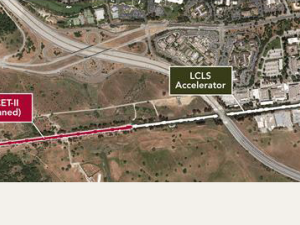FACET-II Science Workshop 2017
Name:
FACET-II Science Workshop 2017
Date:
October 17-20, 2017
Location:
SLAC National Accelerator Laboratory, Kavli Auditorium
Overview:
FACET-II is a new user facility that will provide unique capabilities to develop advanced acceleration and coherent radiation techniques with high-energy electron and positron beams. FACET-II provides a major upgrade over current FACET capabilities and the breadth of the potential research program will make it truly unique.
A baseline design for FACET-II has been established that progressively increases capabilities in three distinct stages and is captured in the FACET-II CDR and TDR. Stage one completes a new photoinjector at Sector 10 and re-establishes operations with high-energy high-brightness electron beams. Stage two will add a new positron damping ring system and allow user runs with high-current positron beams. Stage three will upgrade the chicane in sector 20 for simultaneous delivery of positrons and electrons to the experimental area.
By offering bunch charge ranging from pC to nC, emittance from nm to microns, electrons and positrons, single and double bunches, tailored current profiles of up to nearly 100kA and energy up to 10GeV FACET-II provides experimental capabilities unparalleled anywhere in the world. By leveraging the additional infrastructure afforded by SLAC’s laser group, the FACET laser systems provide multi-terawatt peak powers with state of the art synchronization approaching 10fs.
The FACET-II team is organizing the third of a series of workshops to discuss the scientific opportunities of this new facility, and refine the technical requirements to ensure maximum impact during early operations and into the future. The focus of the current workshop is to asses and chart the development of key technologies needed to to execute the envisioned FACET-II science program.
Agenda:
| Transverse Wakefields with strong beam loading | Emittance vs Loading (introduction, theory with high level simulation results) | Sergei Nageitsev | FNAL |
| Transverse Wakefields with strong beam loading | Theoretical progress (multi-modal analysis) | Xinlu Xu | UCLA/SLAC |
| Transverse Wakefields with strong beam loading | Detailed computational discussion and next steps in understanding emittance vs. loading in PWFA | Weiming An | UCLA |
| Transverse Wakefields with strong beam loading | Lessons learned from FACET and path forward for FACET-II experiment (offset knobs & what we will see on spectrometer) | Erik Adli | U. Oslo |
| Transverse Wakefields with strong beam loading | Diagnostic requirements for witness bunch offsets (r,z) | Mike Litos | UC Boulder |
| Transverse Wakefields with strong beam loading | Calculation of wakefields for plasma-wakefield accelerators | Gennady Stupakov | SLAC |
| Positrons, hollow channels and dielectrics | Hollow channel longitudinal & transverse wakes | Carl Andreas Lindstrom | University of Oslo |
| Positrons, hollow channels and dielectrics | Dielectric Wakefield Accelerators: status & what’s next | Gerard Andonian | UCLA |
| Positrons, hollow channels and dielectrics | Analysis of BBU in compact structure-based wakefield accelerators and a suppression method | Stanislav Baturin | University of Chicago |
| Positrons, hollow channels and dielectrics | Saturation of the beam-hosing instability in quasi-linear plasma-wakefield accelerators | Remi Lehe | LBNL |
| Positrons, hollow channels and dielectrics | Positron PWFA - what we’ve learned and what’s next | Sebastien Corde | Ecole Polytechnique |
| Positrons, hollow channels and dielectrics | Electron Driven Positron Acceleration with the Sailboat Chicane | Weiming An | UCLA |
| Positrons, hollow channels and dielectrics | Non-neutral fireball and possibilities for accelerating positrons with plasma | Jorge Viera | IST |
| Last Name | First Name | Institution |
|---|---|---|
| Adli | Erik | University of Oslo |
| Allen | James | Stanford University/SLAC |
| An | Weiming | UCLA |
| Andonian | Gerard | UCLA |
| Baturin | Stanislav | The University of Chicago |
| Baxevanis | Panagiotis | |
| Benedetti | Carlo | Lawrence Berkeley National Laboratory |
| Blaclard | Guillaume | Lawrence Berkeley National Laboratory |
| Bruhwiler | David | RadiaSoft LLC |
| Cary | John | University of Colorado and Tech-X Corporation |
| Clarke | Christine | SLAC |
| Clayton | Chris | UCLA |
| Corde | Sebastien | Ecole Polytechnique |
| Cowan | Benjamin | Tech-X Corporation |
| D'Arcy | Richard | DESY |
| Emma | Claudio | SLAC National Accelerator Laboratory |
| England | Joel | SLAC |
| Esarey | Eric | LBNL |
| Frisch | Josef | SLAC |
| Green | Selina | SLAC |
| Grismayer | Thomas | GoLP/Instituto de Plasmas e Fusao Nuclear, Universidade de Lisboa |
| Hemsing | Erik | SLAC |
| Higuera | Adam | University of Colorado at Boulder |
| Hogan | Mark | SLAC |
| Huang | Zhirong | SLAC |
| Jing | Yichao | BNL |
| Joshi | Chandrashekhar | UCLA |
| Lehe | Remi | LBNL |
| Len | LK | DOE |
| Lipkowitz | Nate | SLAC |
| Litos | Michael | University of Colorado Boulder |
| Lu | Wei | Tsinghua University |
| Majernik | Nathan | UCLA |
| Marsh | Kenneth | UCLA EE Dept |
| Merminga | Lia | SLAC |
| Meuren | Sebastian | Department of Astrophysical Sciences, Princeton University |
| Murokh | Alex | RadiaBeam Technologies, LLC. |
| Nagaitsev | Sergei | Fermilab/UChicago |
| Ng | Cho-Kuen | SLAC National Accelerator Laboratory |
| O'Shea | Brendan | SLAC |
| Osterhoff | Jens | DESY |
| Pellegrini | Claudio | SLAC |
| Peskin | Michael | SLAC |
| Raubenheimer | Tor | SLAC |
| Reis | David | Stanford PULSE Institue |
| Roeckemann | Jan-Hendrik | DESY |
| Rosenzweig | James | UCLA |
| Ryne | Robert | LBNL |
| Schroeder | Carl | LBNL |
| Seeman | John | SLAC |
| Seryi | Andrei | John Adams Institute |
| Siciak | Antonin | Ecole Polytechnique |
| Storey | Doug | University of Victoria |
| Stupakov | Gennady | SLAC |
| Sutherland | Andrew | SLAC / University of Strathclyde |
| Thévenet | Maxence | Lawrence Berkeley National Laboratory |
| Tudosa | Ioan | UPenn |
| Vafaei-Najafabadi | Navid | Stony Brook University |
| van Tilborg | Jeroen | LBNL |
| Vay | Jean-Luc | LBNL |
| Vieira | Jorge | Instituto Superior Técnico |
| Walz | Dieter | SLAC |
| Xu | Xinlu | UCLA/SLAC |
| Yakimenko | Vitaly | SLAC |
| Yocky | Jerry | SLAC FACET-II |
| Yu | Siyi | Ecole Polytechnique |
| Zholents | Alexander | Argonne National Laboratory |




